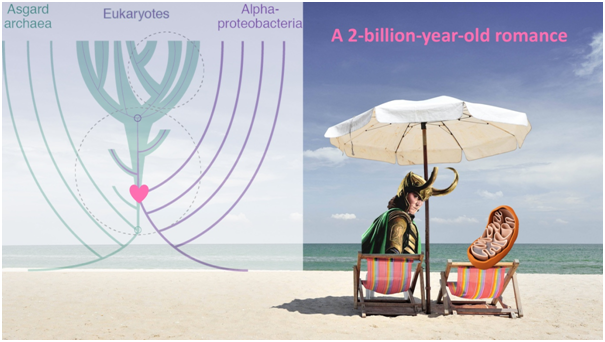Unlike bacteria, organisms like animals and plants contain mitochondria in their cells as energy-producing factories. However, where were mitochondria at the very beginning of these organism’s lives? Recent research led by scholars from Southern University of Science and Technology (SUSTech) has provided the most robust support to the hypothesis that mitochondria came from an ancient alphaproteobacterium.
On July 13, Chair Professor Chuanlun Zhang (Ocean Science and Engineering) has led his research team to make a ground-breaking discovery in their study of the evolutionary relationship between mitochondria and alphaproteobacteria. Their innovative work was published in the high-impact academic journal, Nature: Ecology & Evolution (IF = 10.08). It was titled, “Phylogenetic analyses with systematic taxon sampling show that mitochondria branch within Alphaproteobacteria.”
Bacteria, archaea, and eukarya are the three forms of life on Earth. The origin of these life forms is a fundamental question in science. Bacteria and archaea possibly originated on Earth approx. 4 to 3.5 billion years ago. The origin of mitochondria was first hypothesized in 1905. It is currently accepted that the first eukaryotic cell was formed as a result of an archaeal and bacterial cell (Figure 1).

Figure 1, The formation of the first eukaryotic cell on the Earth was the result of the fusion of a bacterial cell and an archaeal cell in approx. 2 billion years ago. (Modified from Roger 2017 Curr Biol).
The bacterium became a symbiotic partner within the archaeal host. It evolved to be the essential cellular organism in eukaryotic cells called mitochondria. Mitochondria are the energy factory of cells conducting oxygen-dependent respiration and critical for human diseases and aging. Studying bacterial and archaeal lineages involving the origin of the first eukaryotic cell helped scholars understand the time, chemical processes, and metabolic mechanism of eukaryotic life origins. It has helped them determine the environmental characteristics on the Earth at that time. The details in the formation of the new life form can provide vital hints in developing critical synthetic biology technologies.
The central questions behind the origins of eukaryotic life focus on whether the archaeal host was an Asgard archaeon and if the bacterial symbiont was an alphaproteobacterium. The debate on the origin of mitochondria that which extant alphaproteobacterial lineage is the closest relative of mitochondria has raged for many years. As evolution has functioned for over 1.8 billion years, there is scant evidence of molecular evolution. Compositional heterogeneity between alphaproteobacterial groups has dramatically challenged the model fit. It has resulted in artifacts in phylogenetic predictions caused by systematic errors, including long-branch attraction and GC bias.
To detangle this debate of the century, the research team examined the uncertain results produced by site-trimming approaches. They proved that the current popular method of site-trimming could not produce robust phylogenetic predictions in studying the origin of mitochondria (Figure 2).

Figure 2, Cross-validation by multiple algorithms, proves that the popular data pre-treatment method – site trimming – can produce uncertain results. There is no causative relationship between the evolutionary position of mitochondria and model fit.
They further developed a novel strategy of systematic taxon replacement and multiple method cross-validation. The research team successfully reduced systematic errors while keeping evolutionary information intact by comparing over a hundred Bayesian phylogenetic trees and justifying model fit values. The application of these new methods led to the first definition of four major evolutionary clades of Alphaproteobacteria. Mitochondria were then found to originated from the IIb subclade, which includes various marine bacteria and endosymbionts (Figure 3).

Figure 3. Systematic species sampling methods confirmed that mitochondria originated from the IIb branch of Alpha Proteobacteria. They share common ancestors with the endosymbionts of the Rickettsiales and some marine planktonic bacteria that have not been identified.
The research team revisited the methodology in the phylogenetic study of mitochondrial origin. It restored the discussion to the scope of alphaproteobacteria. The paper provides a reliable demonstration of methodology for further research into the closest bacterial ancestor of mitochondria.
Research Assistant Professor Lu Fan is the first author and co-corresponding author of the paper. The other co-corresponding authors are Professor William F. Martin (Heinrich Heine University) and Professor Ruixin Zhu (Department of Bioinformatics, Tongji University). SUSTech is the first corresponding unit.
The study received support from the National Natural Science Foundation of China, the Shenzhen Key Laboratory of Marine Archaea Geo-Omics, SUSTech Research Start-up Grant, and the Southern Marine Science and Engineering Guangdong Laboratory (Guangzhou). The Centre for Computational Science and Engineering (SUSTech) supported the computational requirements of this study.
Proofread ByYingying XIA
Photo ByDepartment of Ocean Science and Engineering, Yan QIU